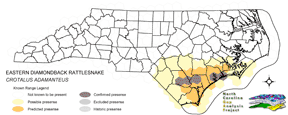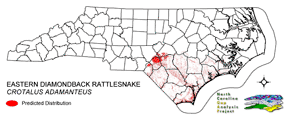
| Taxa: |
| Order: |
| Family: |
| Reptilia |
| Squamata |
| Viperidae |
| NatureServe Global Rank: |
| NatureServe State (NC) Rank: |
| G4 |
| S1 |
| Federal Status: |
| NC State Status: |
| --- |
| SR |


| Land Unit |
| US Fish & Wildlife Service |
| US Forest Service |
| US National Park Service |
| US Department of Defense |
| NC State Parks |
| NC University System |
| NC Wildlife Res. Com. |
| NC Forest Service |
| NC Div. of Coastal Mgmt. |
| Local Governments |
| Non-Governmental Org. |
| Other Public Lands |
| Private Lands |
| GAP Status 1-2 |
| All Protected Lands |
| Statewide |
| Hectares |
| 317.16 |
| 3,812.22 |
| 53,327.88 |
| 205.29 |
| 1,571.49 |
| 470.70 |
| 6,384.15 |
| 3,408.57 |
| 127.71 |
| 186.03 |
| 1,420.65 |
| 61.20 |
| 252,675.36 |
| 5,904.81 |
| 71,167.05 |
| 323,968.41 |
| Acres |
| 783.72 |
| 9,420.20 |
| 131,776.04 |
| 507.28 |
| 3,883.24 |
| 1,163.12 |
| 15,775.58 |
| 8,422.76 |
| 315.58 |
| 459.69 |
| 3,510.50 |
| 151.23 |
| 624,374.29 |
| 14,591.10 |
| 175,857.58 |
| 800,543.22 |
| % of Dist. on |
| Prot. Lands |
| 0.4 % |
| 5.4 % |
| 74.9 % |
| 0.3 % |
| 2.2 % |
| 0.7 % |
| 8.8 % |
| 4.8 % |
| 0.2 % |
| 2.0 % |
| 2.0 % |
| < 0.1 % |
| 0.0 % |
| 8.3 % |
| ----- |
| ----- |
| % of Dist. on |
| All Lands |
| < 0.1 % |
| 1.2 % |
| 16.5 % |
| < 0.1 % |
| 0.5 % |
| 0.1 % |
| 2.0 % |
| 1.1 % |
| < 0.1 % |
| < 0.1 % |
| 0.4 % |
| < 0.1 % |
| 78.0 % |
| 1.8 % |
| ----- |
| ----- |
|
NATURE SERVE GLOBAL HABITAT COMMENTS: Pine and wiregrass flatwoods, longleaf pine-turkey oak hills, rosemary scrub, palmetto flatwoods, mesophytic hammocks, barrier islands and coastal scrub habitats, vicinity of wet savannas, mixed pine-hardwood successional woodland, abandoned farms and fields, and grown up pastures. Usually not in marshes or swamps but may pass through or occupy edges. Large tracts of habitat are most suitable. Favors areas with abundant cover. Basically terrestrial; rarely climbs into vegetation. Sometimes crosses fresh or salt water. When inactive (e.g., November-March), occupies stump holes, burrows of other animals, brush piles, or similar sites. Stumpholes in shortleaf/loblolly pine oldfield successional forest were utilized more frequently than burrows of the gopher tortoise (GOPHERUS POLYPHEMUS) (Means 1995). Eastern diamondbacks can tolerate inundation of their overwintering burrows, having the capability of remaining underwater for periods up to about one hour (Means 1982, 1995). According to Ernst (1992), most young are born in retreats such as gopher tortoise burrows or hollow logs. NATURE SERVE STATE HABITAT COMMENTS: A forest dweller. Pine flatwoods, pocosins, sand ridges, and edges of fields bordering these woodlands. |
| Code | Name | Description | NC Natural Heritage Program Equivalent |
| 121 | Maritime Pinelands | Loblolly forests and woodlands of the outer coastal plain. | Estuarine Fringe Loblolly Pine Forest |
| 17 | Maritime Forests and Hammocks | Maritime forests and woodlands dominated by live or sand laurel oak. Estuarine Fringe forests dominated by loblolly pine. | Coastal Fringe Evergreen Forest, Maritime Deciduous Forest, Maritime Deciduous Forest |
| 30 | Cypress-Gum Floodplain Forests | Swamps dominated by black or swamp tupelo with or without Taxodium. Seasonally to semi-permanently flooded hydrology. | Cypress-Gum Swamps |
| 78 | Pond-Cypress - Gum Swamps, Savannas and Lakeshores | Cypress dominated swamps and lakeshores. Can include bays dominated by pond cypress or shorelines of coastal plain lakes with a narrow band of cypress. | Non-riverine Swamp Forest, Natural Lakeshores (in part) |
| 97 | Mesic Longleaf Pine | Longleaf pine woodlands without a major scrub oak component. Slash or loblolly pines may be present as well. | Mesic Pine Flatwoods |
| 42 | Xeric Longleaf Pine | Sandhills including a range of longleaf pine density from predominantly wiregrass, scrub oak dominated to true longleaf pine woodland. This does not include mesic or saturated flatwood types. | Xeric Sandhill Scrub, Pine/Scrub Oak Sandhill, Coastal Fringe Sandhill |
| 46 | Xeric Oak - Pine Forests | Mixed forest dominated by yellow pines with white or northern red oaks co-dominating. | Pine Oak Heath |
| 232 | Xeric Pine-Hardwood Woodlands and Forests | Mixed forest dominated by yellow pines with drier oaks including southern red, post, and chestnut oaks. | Dry Oak Hickory Forest |
|
Means, D. B. 1982. Responses to winter flooding of the gopher tortoise (GOPHERUS POLYPHEMUS Daudin). Herpetologica 38:521-525.
Gloyd, H. 1940. The rattlesnakes. Chicago Academy Science, Special Publication No. 4. Conant, R. and J. T. Collins. 1991. A field guide to reptiles and amphibians:eastern and central North America. Third edition. Houghton Mifflin Co., Boston, Massachusetts. 450 pp. Campbell, J. A., and E. D. Brodie, Jr., editors. Biology of the pit vipers. Selva, Tyler, Texas. Ernst, C. H. 1992. Venomous reptiles of North America. Smithsonian Inst. Press, Washington, D.C. ix + 236 pp. McCranie, J. R. 1980. Crotalus adamanteus. Cat. Am. Amph.Rep. 252.1-252.2. Klauber, L. M. 1972. Rattlesnakes:their habits, life histories, and influence on mankind. Second edition. Two volumes. Univ. California Press, Berkeley. Conant, R. 1975. A Field Guide to Reptiles and Amphibians of Eastern and Central North America. Second Edition. Houghton Mifflin Company, Boston, Massachusetts. xvii + 429 pp. Mount, R. H. 1975. The Reptiles and Amphibians of Alabama. Auburn University Agricultural Experiment Station, Auburn, Alabama. vii + 347 pp. Behler, J. L., and F. W. King. 1979. The Audubon Society field guide to North American reptiles and amphibians. Alfred A. Knopf, New York. 719 pp. Martof, B. S., W. M. Palmer, J. R. Bailey, and J. R. Harrison, III. 1980. Amphibians and reptiles of the Carolinas and Virginia. University of North Carolina Press, Chapel Hill, North Carolina. 264 pp. Ashton, R. E., Jr., and P. S. Ashton. 1981. Handbook of Reptiles and Amphibians of Florida. Part One:The Snakes. Windward Pub. Co., Miami, Florida. 176 pp. Ernst, C. H., and R. W. Barbour. 1989. Snakes of eastern North America. George Mason Univ. Press, Fairfax, Virginia. 282 pp. |
For more information please contact them at:
NC-GAP Analysis Project
Dept. of Zoology, NCSU
Campus Box 7617
Raleigh, NC 27695-7617
(919) 513-2853
www.basic.ncsu.edu/ncgap